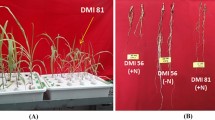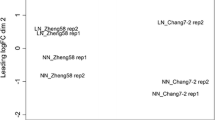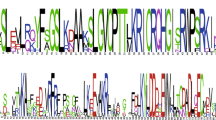Abstract
The global gene expression changes in response to low nitrogen stress in leaf tissues of two maize inbred lines(Mo17 and Hz4) with contrasting low nitrogen tolerance was analyzed using the Affymetrix maize genome array. Our results showed 887 genes involved in a variety of biological processes were responsive to low nitrogen treatment in Mo17, out of which 384 were up-regulated and 503 were down-regulated. In Hz4 the expression of 1108 genes was changed, of which 696 were up-regulated and 412 genes were down-regulated. The gene expression profiles also revealed 1799 genes differentially expressed (910 and 889 genes with higher level of expression in Hz4 and Mo17, respectively) between the two lines under low nitrogen conditions. These results explain at the transcript level why Mo17 is more sensitive than Hz4 under low nitrogen stress. In addition to previously reported nitrogen response genes (nitrate transporter, nitrite reductase, nitrate reductase, ferredoxin) we found many new nitrogen response genes (early light-inducible protein, uroporphyrinogen methyltransferas e, phosphoenolpyruvate carboxylase, tonoplast intrinsic protein, sesquiterpene cyclase). Our results not only provide new insights on the molecular mechanisms of nitrogen stress, but also serve as a valuable resource to researchers who aim to improve the efficiency of maize nitrogen use.
Similar content being viewed by others
References
Agrama HAS, Zakaria AG, Said FB and Tuinstra M (1999) Identification of quantitative trait loci for nitrogen use efficiency in maize. Mol. Breed. 5: 187–195
Beman JM, Arrigo K and Matson PM (2005) Agricultural runoff fuels large phytoplankton blooms in vulnerable areas of the ocean. Nature 434: 211–214.
Benjamini Y and Hochberg Y (1995) Controlling the false discovery rate: a practical and powerful approach for multiple testing. J. R. Statist. Soc B 57:289–300
Bertin P and Gallais A (2001) Physiological and genetic basis of nitrogen use efficiency in maize. II. QTL detection and coincidences. Maydica 46: 53–68.
Cao MJ, Ying Y and Ling ZC (2000) Corn Screening and Evaluation of Stress-resistant to low nitrogen. J. Maize Sci. 4: 64–49
Frink CR and Waggoner PE (1999) Nitrogen fertilizer: Retrospect and prospect. Proc. Natl. Acad. Sci. USA 96: 1175–1180
Irizarry RA, Hobbs B, Collin F, Beazer-Barclay YD, Antonellis KJ, Scherf U and Speed TP (2003) Exploration, normalization, and summaries of high density oligonucleotide array probe level data. Biostatistics 4:249–64.
Le Gouis J, Béghin D, Heumez E and Pluchard P (2000) Genetic differences for nitrogen uptake and nitrogen utilization efficiencies in winter wheat. Eur. J. Agron. 12:163–173.
Li Y, Du J, Wang TY, Shi Y, Song Y and Jia J (2002) Genetic diversity and relationships among Chinese maize inbred lines revealed by SSR markers. Maydica 47: 93–101
London JG (2005) Nitrogen study fertilizes fears of pollution. Nature 433: 791.
Lian XM, **ng YZ, Yan H, Xu CG, Li XH and Zhang QF (2005) QTLs for low nitrogen tolerance at seedling stage identified using a recombinant inbred line population derived from an elite rice hybrid. Theor. Appl. Genet. 112: 85–96
Laperche A, Brancourt-Hulmel M, Heumez E, Gardet O, Hanocq E, Devienne-Barret F and Gouis JL (2007) Using genotype×nitrogen interaction variables to evaluate the QTL involved in wheat tolerance to nitrogen constraints. Theor. Appl. Genet. 115:399–415
Lian X, Wang S, Zhang J, Feng Q, Zhang L, Fan D, Li X, Yuan D, Han B and Zhang Q (2006) Expression profiles of 10,422 genes at early stage of low nitrogen stress in rice assayed using a cDNA microarray. Plant Mol. Biol. 60:617–631
Matsumura T, Sakakibara H, Nakano R, Kimata Y, Sugiyama T and Hase T (1997) A nitrate-inducible ferredoxin in maize roots-Genomic organization and differential expression of two nonphotosynthetic ferredoxin isoproteins. Plant Physiol. 114: 653–660.
Olivier L, Chaillou S, Merigout P, Talbotec J, and Daniel-Vedele F (2003) Quantitative Trait Loci Analysis of Nitrogen Use Efficiency in Arabidopsis. Plant Physiol. 131: 345–358
Pan XM, Tan J and Yang JY (2002) Study on Yield Combining Ability and Genetic Relationship Between Exotic Tropical, Subtropical Maize Inbreds and Domestic Temperate Inbreeds. Sci. Agr. Sinica 35:743–749
Peng MS, Bi YM, Zhu T and Rothstein SJ (2007) Genome-wide analysis of Arabidopsis responsive transcriptome to nitrogen limitation and its regulation by the ubiquitin ligase gene NLA. Plant Mol. Biol. 65: 775–797
Price J, Laxmi A, St Martin SK and Jang JC (2004) Global transcription profiling reveals multiple sugar signal transduction mechanisms in Arabidopsis. Plant Cell 16:2128–2150.
Rensink WA, Buell CR (2005) Microarray expression profiling resources for plant genomics. Trends Plant Sci. 10: 603–609
Ramos C (1995) Effect of agricultural practices on the nitrogen losses to the environment. Fertilizer Research 43:183–189
Ruuska SA, Lewis DC, Kennedy G, Furbank RT, Jenkins and Tabe LM (2007) Large scale transcriptome analysis of the effects of nitrogen nutrition on accumulation of stem carbohydrate reserves in reprodcutive stage wheat. Plant Mol. Biol. 66: 15–32
Stulen I, Perez-Soba M, De Kok LJ and Van Der Eerden L (1998) Impact of gaseous nitrogen deposition on plant functioning. New Phytol. 139:61–70.
Sakakibara H., Takei K., and Sugiyama T (1996) Isolation and characterization of a cDNA that encodes maize uroporphyrinogen III methyltransferase, an enzyme involved in the synthesis of siroheme, which is a prosthetic group of nitrite reductase. Plant J. 10:883–892.
Scheible W.R., Lauerer M., Schulze E.D., Caboche M., and Stitt M (1997) Accumulation of nitrate in the shoot acts as a signal to regulate shoot-root allocation in tobacco. Plant J. 11: 671–691.
Scheible WR, Morcuende R, Czechowski T, Fritz C, Osuna D, Palacios-Rojas N, Schindelasch D, Thimm O, Udvardi MK and Stitt M (2004) Genome-wide reprogramming of primary and secondary metabolism, protein synthesis, cellular growth processes, and the regulatory infrastructure of Arabidopsis in response to nitrogen. Plant Physiol. 136: 2483–2499.
Stitt M (1999) Nitrate regulation of metabolism and growth. Curr. Opin. Plant Biol. 2:178–186
Wang R, Guegler K, LaBrie ST and Crawford NM (2000) Genomic analysis of a nutrient response in Arabidopsis reveals diverse expression patterns and novel metabolic and potential regulatory genes that are induced by nitrate. Plant Cell 12:1491–1510
Wang YH, Garvin DF and Kochian LV (2001) Nitrate-induced genes in tomato roots. Array analysis reveals novel genes that may play a role in nitrogen nutrition. Plant Physiol. 127: 345–359
Wang RC, Mamoru Okamoto, **ng XJ and Nigel M. Crawford (2003) Microarray Analysis of the Nitrate Response in Arabidopsis Roots and Shoots Reveals over 1,000 Rapidly Responding Genes and New Linkages to Glucose, Trehalose-6-Phosphate, Iron, and Sulfate Metabolism. Plant Physiol. 132: 556–567
**e CX, Zhang SH, Li MS, Li XH, Hao ZF, Bai L, Zhang DG amd Liang YH (2007) Inferring Genome Ancestry and Estimating Molecular Relatedness Among 187 Chinese Maize Inbred Lines. J. Genet. Genomics 34:738–748
Yan XL, Wu P, Ling HQ, Xu GH, Xu FS and Zhang QF (2006) Plant Nutriomics in China: An Overview. Ann. Bot. 98:473–48
Author information
Authors and Affiliations
Corresponding authors
Rights and permissions
About this article
Cite this article
Chen, R., Tian, M., Wu, X. et al. Differential global gene expression changes in response to low nitrogen stress in two maize inbred lines with contrasting low nitrogen tolerance. Genes Genom 33, 491–497 (2011). https://doi.org/10.1007/s13258-010-0163-x
Received:
Accepted:
Published:
Issue Date:
DOI: https://doi.org/10.1007/s13258-010-0163-x




